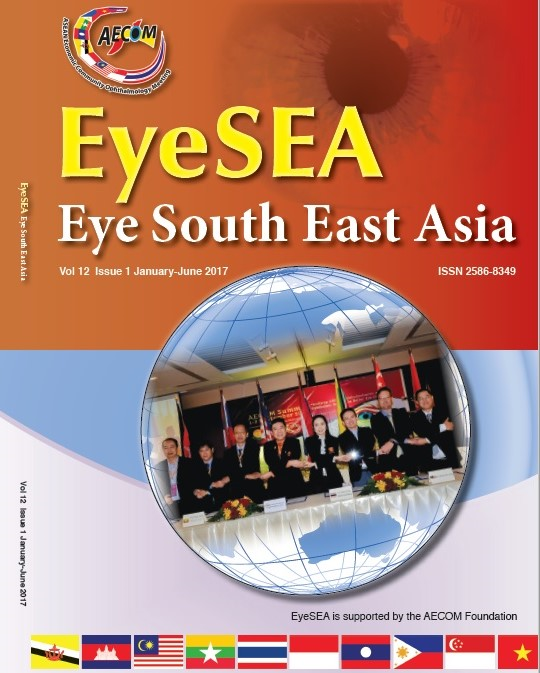Risk factor for pterygium in Cambodian People
Main Article Content
Abstract
Introduction: Pterygium is one of the most common eye diseases around the world especially asia. Many study about pterygium show that residence; age, race, sex, sunlight exposure, and education level were with risk for pterygium. At the moment, the exact the pathogenesis of pterygium remains unclear.
Objevtive: To determine the risk factor of pterygium in a group of Cambodian people.
Materiel and Methods: Data were analyzed from 183 participants, in Preah Ang Doung Hospital and Takeo Eye Hospital, age ranged from 20-80 years old. Participants were asked to answer the questionnaire related to their everyday activities.
Results: Male was affected more than female. The most affected age range was 50-59 years old. The participant who live and work in the province were more populated with pterygium than that from the city. More than 70% of the participants never have protection during work
Conclusion: Pterygium was positively associated with older age and outdoor time and use of hat and/or sunglasses
Article Details
References
K. Droutsas and W. Sekundo, “Epidemiology of pterygium: a review,” Ophthalmologe, vol. 107, no. 6, pp. 511–516, 2010.
K. Zheng, J. Cai, V. Jhanji, and H. Chen, “Comparison of pterygium recurrence rates after limbal conjunctival autograft transplantation and other techniques: meta-analysis,” Cornea, vol. 31, no. 12, pp. 1422–1427, 2012.
N. di Girolamo, J. Chui, M. T. Coroneo, and D. Wakefield, “Pathogenesis of pterygia: role of cytokines, growth factors, and matrix metalloproteinases,” Progress in Retinal and Eye Research, vol. 23, no. 2, pp. 195–228, 2004.
M. S. Oliva and H. Taylor, “Ultraviolet radiation and the eye,” International Ophthalmology Clinics, vol. 45, no. 1, pp. 1–17, 2005.
A.Fotouhi,H.Hashemi,M.Khabazkhoob,andK.Mohammad, “Prevalence and risk factors of pterygium and pinguecula: the Tehran Eye Study,” Eye, vol. 23, no. 5, pp. 1125–1129, 2009.
G. Gazzard, S.-M. Saw, M. Farook et al., “Pterygium in Indone- sia: prevalence, severity and risk factors,” British Journal of Ophthalmology, vol. 86, no. 12, pp. 1341–1346, 2002.
K. Wu, M. He, J. Xu, and S. Li, “Pterygium in aged population in Doumen County, China,” Yan Ke Xue Bao, vol. 18, no. 3, pp. 181–184, 2002.
C. A. McCarty, C. L. Fu, and H. R. Taylor, “Epidemiology of pterygium in Victoria, Australia,” British Journal of Ophthalmol- ogy, vol. 84, no. 3, pp. 289–292, 2000.
R. Luthra, B. B. Nemesure, S. Y. Wu, S. H. Xie, and M. C. Leske, “Frequency and risk factors for pterygium in the Barbados Eye Study,” Archives of Ophthalmology, vol. 119, no. 12, pp. 1827–1832, 2001.
F.S.Rosenthal,A.E.Bakalian,C.Q.Lou,andH.R.Taylor,“The effect of sunglasses on ocular exposure to ultraviolet radiation,” American Journal of Public Health, vol. 78, no. 1, pp. 72–74, 1988.
R. Detels and S. P. Dhir, “Pterygium: a geographical study,” Archives of Ophthalmology, vol. 78, no. 4, pp. 485–491, 1967.


